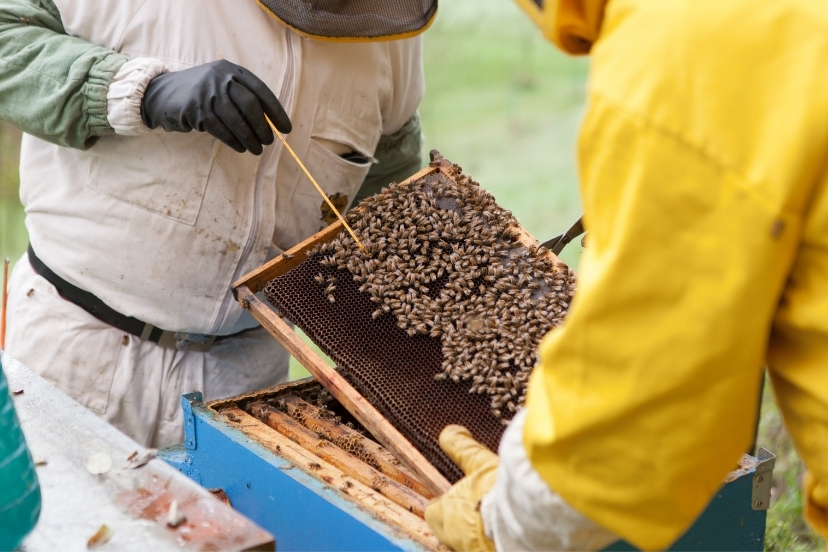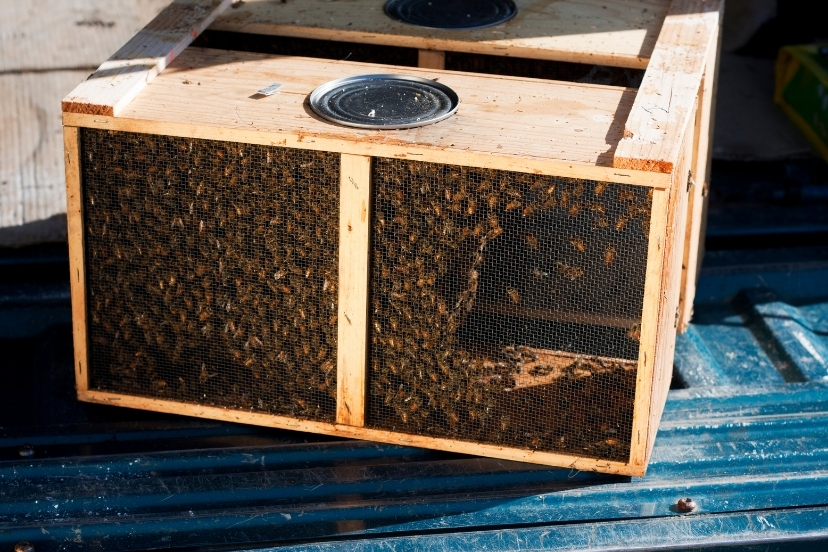The queen bee of a honey bee colony is not a ruling monarch – far from it.
In fact, calling her a queen is quite a misnomer. She makes no decisions beyond choosing in which cells to lay her eggs.
But in one sense, the term fits, for she is the most important member of the hive.
She is the mother of all of the bees in the hive, and if a colony becomes permanently queenless, it dies.
A Queen is Born
All of the bees in a colony begin life as an egg laid by the honey bee queen.
But when the colony decides to raise a new queen, it does so by feeding a special diet to a recently hatched egg.
This special diet is a substance called royal jelly. By eating this food, which is fed only to a queen-to-be, an egg that was otherwise destined to become an ordinary worker, instead grows into a queen honey bee.
When the queen is 16 days old, she emerges from her cell, ready to begin her life as an adult.
And as the first order of business, she has a rather nasty job to perform…
Honey bee queen surrounded by worker bees
There’s Only Room For One Queen
When a hive decides to raise a new queen, usually there will be several queens raised simultaneously.
After all, the future of the colony depends upon the queen, so to increase the odds of successfully transitioning to a new queen, the hive will raise several at once. If something goes wrong in raising one of the queens, one of the others can take her place.
But normally, a hive has only one queen. So the first queen to emerge from her cell destroys the others.
She roams through the hives, searching for the cells of her sister queen bees. When she finds one, she ruthlessly tears into it, causing the death of her young sister (worker bees usually finish the job).
If one or more young queens happen to emerge at the same time, they will fight it out until only one remains.
And if two older queen bees happen to end up in the same colony (such as when a beekeeper joins two colonies), they will fight to the death.
There’s only room at the top for one!
It’s interesting to note that although queens can sting, the only circumstance in which they will use their sting is in fighting another queen.
They won’t even sting to protect themselves. Beekeepers can pick up and handle queens without any fear of being stung.
Nuptuals
Usually 5 to 10 days after emerging from its cell, the young queen will go on her mating flight.
Male bees, called drones, find the queen while she is flying, and mate with her in flight. She mates with several drones on this one flight, and then never mates again.
And she will never fly or leave the hive again, unless she accompanies a swarm.
An Egg-Laying Machine
Once the queen bee begins her life’s work of laying eggs, that is all she does.
She chooses a cell – usually pokes her head in the cell first as though inspecting its suitability – and then inserts her rear into the cell and deposits an egg in the bottom. And then she does the same thing again, and again, and again.
During the height of the season, a queen can average laying 1500 eggs per day, and can lay over 200,000 per year.
The only break in her egg-laying routine (other than during coldest winter) occurs when the colony decides to swarm. When this happens, the queen is usually forced to leave with the swarm.
The bees remaining in the original hive raise a new queen.
The Queen is Deposed
The queen bee can live for several years, but very rarely does she die a natural death.
As she ages, her egg-laying capacity gradually declines.
When the day comes that she is no longer productive enough to satisfy her daughters, they turn on her and commit matricide. In a rush, the queen is suddenly covered with her daughters ripping at her wings, tearing at her legs, and attempting to sting her.
Once she is dead, her body is disposed of by removing it from the hive, and a new queen honey bee is reared to take her place.
Long live the queen!


